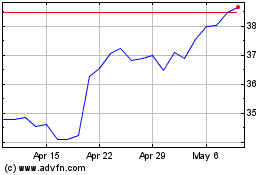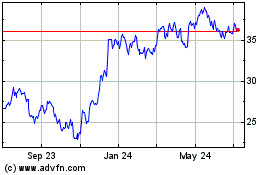On November 21, 2016, Vantiv, Inc. (NYSE: VNTV) conducted a
secondary offering of 4.8 million shares of its Class A common
stock on behalf of Fifth Third (Nasdaq: FITB). Vantiv is also
concurrently repurchasing 850,000 shares of Vantiv Class A common
stock from Fifth Third. The 5.65 million shares being sold by Fifth
Third through these transactions were obtained through the net
exercise of the entire remaining warrant position in Vantiv
Holding, LLC and the exchange of those Vantiv Holding, LLC units
for Class A shares of common stock in Vantiv, Inc. The warrant
position gave Fifth Third the right to purchase approximately 7.8
million Class C units at a $15.98 strike price, which was settled
through the net issuance of 5.65 million units.
The warrant exercise and related sale of Vantiv stock is
consistent with Fifth Third’s goal of monetizing its remaining
stake in Vantiv over time. The exercise of the entire remaining
warrant will also serve to reduce the volatility of Fifth Third’s
earnings by eliminating fair value adjustments related to the
warrant. “We continue to take a deliberate and thoughtful approach
to reducing our ownership interests in Vantiv,” said Greg
Carmichael, Chief Executive Officer of Fifth Third. “Since the sale
of a majority interest in Vantiv in 2009, the warrant position has
generated approximately $528 million in after-tax value for Fifth
Third’s shareholders.”
During the fourth quarter, Fifth Third expects to recognize a
pre-tax gain of approximately $9 million (approximately $6 million
after tax) related to these transactions. It will also add
approximately 4 bps to Fifth Third’s Common Equity Tier 1 ratio.
Following the offering and concurrent repurchase of shares by
Vantiv, Inc., Fifth Third will beneficially own approximately 17.9%
of Vantiv’s equity through its ownership of approximately 35
million Class B units of Vantiv Holding, LLC.
If the offering is consummated, Fifth Third will be entitled to
appoint one director to Vantiv’s board of directors instead of two.
Accordingly, Vantiv intends to decrease the size of its board to 11
members, and expects that one of the Fifth Third directors will
resign from Vantiv’s board. Fifth Third will continue to account
for its ownership in Vantiv under the equity method of accounting
given the combination of its level of ownership in the outstanding
voting interests of Vantiv, the significant contractual
arrangements between Vantiv and Fifth Third and Fifth Third’s
continued representation on the board of directors of Vantiv.
In connection with these transactions, Vantiv is expected to
record a liability of approximately $175 million related to
potential cash payments owed to Fifth Third over the next 15 plus
years under the Tax Receivable Agreement.
Fifth Third Bancorp is a diversified financial services company
headquartered in Cincinnati, Ohio. As of September 30, 2016, the
Company had $143 billion in assets and operates 1,191 full-service
Banking Centers, including 94 Bank Mart® locations, most open seven
days a week, inside select grocery stores and 2,497 ATMs in Ohio,
Kentucky, Indiana, Michigan, Illinois, Florida, Tennessee, West
Virginia, Georgia and North Carolina. Fifth Third operates four
main businesses: Commercial Banking, Branch Banking, Consumer
Lending, and Wealth & Asset Management. As of September 30,
2016, Fifth Third also had an 18.3% interest in Vantiv Holding,
LLC. Fifth Third is among the largest money managers in the Midwest
and, as of September 30, 2016, had $314 billion in assets under
care, of which it managed $27 billion for individuals, corporations
and not-for-profit organizations. Investor information and press
releases can be viewed at www.53.com. Fifth Third’s common stock is
traded on the NASDAQ® Global Select Market under the symbol
“FITB.”
Forward Looking Statements
This release contains statements that we believe are
“forward-looking statements” within the meaning of Section 27A of
the Securities Act of 1933, as amended, and Rule 175 promulgated
thereunder, and Section 21E of the Securities Exchange Act of 1934,
as amended, and Rule 3b-6 promulgated thereunder. These statements
relate to our financial condition, results of operations, plans,
objectives, future performance or business. They usually can be
identified by the use of forward-looking language such as “will
likely result,” “may,” “are expected to,” “anticipates,”
“potential,” “estimate,” “forecast,” “projected,” “intends to,” or
may include other similar words or phrases such as “believes,”
“plans,” “trend,” “objective,” “continue,” “remain,” or similar
expressions, or future or conditional verbs such as “will,”
“would,” “should,” “could,” “might,” “can,” or similar verbs. You
should not place undue reliance on these statements, as they are
subject to risks and uncertainties, including but not limited to
the risk factors set forth in our most recent Annual Report on Form
10-K as updated from time to time by our Quarterly Reports on Form
10-Q. When considering these forward-looking statements, you should
keep in mind these risks and uncertainties, as well as any
cautionary statements we may make. Moreover, you should treat these
statements as speaking only as of the date they are made and based
only on information then actually known to us. There is a risk that
additional information may become known during the company’s
quarterly closing process or as a result of subsequent events that
could affect the accuracy of the statements and financial
information contained herein.
There are a number of important factors that could cause future
results to differ materially from historical performance and these
forward-looking statements. Factors that might cause such a
difference include, but are not limited to: (1) general economic or
real estate market conditions, either nationally or in the states
in which Fifth Third, one or more acquired entities and/or the
combined company do business, weaken or are less favorable than
expected; (2) deteriorating credit quality; (3) political
developments, wars or other hostilities may disrupt or increase
volatility in securities markets or other economic conditions; (4)
changes in the interest rate environment reduce interest margins;
(5) prepayment speeds, loan origination and sale volumes,
charge-offs and loan loss provisions; (6) Fifth Third’s ability to
maintain required capital levels and adequate sources of funding
and liquidity; (7) maintaining capital requirements and adequate
sources of funding and liquidity may limit Fifth Third’s operations
and potential growth; (8) changes and trends in capital markets;
(9) problems encountered by larger or similar financial
institutions may adversely affect the banking industry and/or Fifth
Third; (10) competitive pressures among depository institutions
increase significantly; (11) effects of critical accounting
policies and judgments; (12) changes in accounting policies or
procedures as may be required by the Financial Accounting Standards
Board (FASB) or other regulatory agencies; (13) legislative or
regulatory changes or actions, or significant litigation, adversely
affect Fifth Third, one or more acquired entities and/or the
combined company or the businesses in which Fifth Third, one or
more acquired entities and/or the combined company are engaged,
including the Dodd-Frank Wall Street Reform and Consumer Protection
Act; (14) ability to maintain favorable ratings from rating
agencies; (15) fluctuation of Fifth Third’s stock price; (16)
ability to attract and retain key personnel; (17) ability to
receive dividends from its subsidiaries; (18) potentially dilutive
effect of future acquisitions on current shareholders’ ownership of
Fifth Third; (19) effects of accounting or financial results of one
or more acquired entities; (20) difficulties from Fifth Third’s
investment in, relationship with, and nature of the operations of
Vantiv, LLC; (21) loss of income from any sale or potential sale of
businesses; (22) difficulties in separating the operations of any
branches or other assets divested; (23) losses or adverse impacts
on the carrying values of branches and long-lived assets in
connection with their sales or anticipated sales; (24) inability to
achieve expected benefits from branch consolidations and planned
sales within desired timeframes, if at all; (25) ability to secure
confidential information and deliver products and services through
the use of computer systems and telecommunications networks; and
(26) the impact of reputational risk created by these developments
on such matters as business generation and retention, funding and
liquidity.
You should refer to our periodic and current reports filed with
the Securities and Exchange Commission, or “SEC,” for further
information on other factors, which could cause actual results to
be significantly different from those expressed or implied by these
forward-looking statements.
View source
version on businesswire.com: http://www.businesswire.com/news/home/20161122005616/en/
Fifth Third BancorpSameer Gokhale (Investors),
513-534-2219orLarry Magnesen (Media), 513-534-8055
Fifth Third Bancorp (NASDAQ:FITB)
Historical Stock Chart
From Mar 2024 to Apr 2024

Fifth Third Bancorp (NASDAQ:FITB)
Historical Stock Chart
From Apr 2023 to Apr 2024
